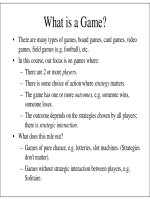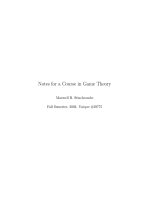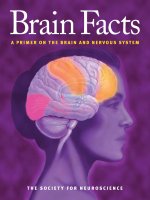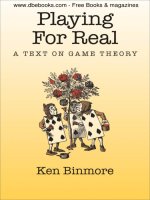- Trang chủ >>
- Khoa Học Tự Nhiên >>
- Vật lý
playing for real a text on game theory mar 2007
Bạn đang xem bản rút gọn của tài liệu. Xem và tải ngay bản đầy đủ của tài liệu tại đây (10.69 MB, 652 trang )
www.dbebooks.com - Free Books & magazines
Playing for Real
This page intentionally left blank
Playing for Real
A Text on Game Theory
Ken Binmore
1
2007
1
Oxford University Press, Inc., publishes works that further
Oxford University’s objective of excellence
in research, scholarship, and education.
Oxford New York
Auckland Cape Town Dar es Salaam Hong Kong Karachi
Kuala Lumpur Madrid Melbourne Mexico City Nairobi
New Delhi Shanghai Taipei Toronto
With offices in
Argentina Austria Brazil Chile Czech Republic France Greece
Guatemala Hungary Italy Japan Poland Portugal Singapore
South Korea Switzerland Thailand Turkey Ukraine Vietnam
Copyright # 2007 by Oxford University Press, Inc.
Published by Oxford University Press, Inc.
198 Madison Avenue, New York, New York 10016
www.oup.com
Oxford is a registered trademark of Oxford University Press
All rights reserved. No part of this publication may be reproduced,
stored in a retrieval system, or transmitted, in any form or by any means,
electronic, mechanical, photocopying, recording, or otherwise,
without the prior permission of Oxford University Press.
Library of Congress Cataloging-in-Publication Data
Binmore, K. G., 1940–
Playing for real : a text on game theory / Ken Binmore.
p. cm.
Includes index.
ISBN 978-0-19-530057-4
1. Game theory. 1. Title.
QA269.B475 2005
519.3—dc22 2005053938
135798642
Printed in the United States of America
on acid-free paper
I dedicate Playing for Real to my wife, Josephine
This page intentionally left blank
Preface
There are at least three questions a game theory book might answer:
What is game theory about?
How do I apply game theory?
Why is game theory right?
Playing for Real tries to answer all three questions. I think it is the only book that
makes a serious attempt to do so without getting heavily mathematical. There are
elementary books that offer students the opportunity to admire some game theory
concepts. There are cookbooks that run through lots of applied models. There are
philosophical works that supposedly address the foundational issues, but none of
these address more than two of the questions.
However, answering questions is only part of what this book is about. Just as
athletes take pleasure in training their bodies, so there is immense satisfaction to be
found in training your mind to think in a way that is simultaneously rational and
creative. With all of its puzzles and paradoxes, game theory provides a magnificent
mental gymnasium for this purpose. I hope that exercising on the equipment will
bring you the same kind of pleasure it has brought me.
Moving on. Playing for Real isn’t my first textbook on game theory. My earlier
book, Fun and Games, was used quite widely for teaching advanced undergraduate
and beginning graduate students. I had originally planned a modestly revised second
edition, in which the rather severe introduction would be replaced with a new
chapter that would ease students into the subject by running through all the angles on
the Prisoners’ Dilemma. The remaining chapters were then simply to be broken
down into more digestible chunks. But the project ran away with me. I made the
improvements I planned to make but somehow ended up with a whole new book.
There are two reasons why. The first is that game theory has moved on since I
wrote Fun and Games. Some of the decisions on what material to include that
seemed a little daring at the time now look totally uncontroversial. So I have tried
my luck at guessing which way the subject is going to jump again.
The second reason is that I have moved on as well. In particular, I have done a
great deal of consulting work, applying game theory to real-world problems in order
to raise money for my research center. The biggest project was the design of a
telecom auction that raised $35 billion. I always knew that game theory works, but
seeing it triumph on such a scale was beyond all expectation! I have also written a
book applying game theory to philosophical issues, which taught me a great deal
about how and why beginners make mistakes when thinking about strategic issues.
Both kinds of experience have contributed to making Playing for Real a better book
than its predecessor. My flirtation with philosophy even generated a lot of light-
hearted exercises that nevertheless make genuinely serious points.
Material. As a text on game theory for undergraduates with some mathematical
training, Playing for Real improves on Fun and Games in a number of ways. It
continues to be suitable for courses attended by students from a variety of disci-
plines. (Some of my very best undergraduates at the University of Michigan were
from Classics.) It also continues to provide backup sections on the necessary
mathematics, so that students whose skills are rusty can keep up with what’s going
on without too much effort. However, the book as a whole covers fewer basic topics
in a more relaxed and discursive style, with many more examples and economic
applications.
I hope the opening chapter, which uses the Prisoners’ Dilemma to provide an
undemanding overview of what game theory is all about, will prove to be a par-
ticularly attractive feature. Economists will also be pleased to see a whole chapter
devoted to the theory of imperfect competition, where I believe I may even have
made Bertrand-Edgeworth competition accessible to undergraduates. It is a tragedy
that evolutionary game theory had to go, but this important subject has gotten so big
that it deserves a whole book to itself.
Although fewer topics are covered, some topics are covered in much more detail
than in Fun and Games . These include cooperative game theory, Bayesian decision
theory, games of incomplete information, mec hanism design, and auction theory,
each of which now has its own chapter. However, the theory of bargaining has
grown more than anything else, partly because I hope to discourage various mis-
understandings of the theory that have become commonplace in applied work, and
partly because I wanted to illustrate its potential use in ethics and moral philosophy.
Teaching. There is enough material in this book for at least two courses in game
theory, even leaving aside the review and other sections that are intended for private
reading. I have tried to make things easy for teachers who want to design a course
based on a selection of topics from the whole book by including marginal notes to
facilitate skipping. For example, the Mad Hatter, who has appeared in the margin,
suggests skipping on to the first chapter, on the grounds that there is too much
philosophy in this preface.
The exercises are similarly labeled with warnings about their content. Nobody
will want to attempt all of the enormous number of exercises, but when I teach, I
insist on students trying a small number of carefully chosen exercises every week.
phil
!
1.1
viii Preface
Once they get into the habit, students are often surprised to find that solving prob-
lems can be a lot of fun.
By the time the book is published, Jernej Copic will have finish ed getting his
solutions onto a website. Oxford University Press will provide access details to
recognized teacher s.
Thanks. So many people have helped me, with both Fun and Games and Playing for
Real, that I have lost track of them all. I shall therefore mention only the very special
debt of gratitude I owe to my long-tim e coauthor, Larry Samuelson, for both his
patience and his encouragement. I also want to thank the California Institute of
Technology for giving me the leisure to complete this book as a Gordon Moor e
Scholar. I should also acknowledge the Victorian artist John Tenniel, whose mag-
nificent illustrations from Lewis Carroll’s Alice books I have shamelessly stolen and
messed around with.
Apologies. Let me aopolgize in advance for the errors that have doubtless found
their way into Playing for Real. If you find an error, please join the many others who
have helped me by letting me know about it at I will be
genuinely grateful.
Finally, I need to apologize not only for my mistakes but also for my attempts at
humor. Oscar Wilde reported that a piano in a Western saloon carried a notice
saying, ‘‘Please don’t shoot the pianist. He’s doing his best.’’ The same goes for me,
too. It isn’t easy to write in a light-hearted style when presenting mathematical
material, but I did my best. Ken Binmore
Preface ix
This page intentionally left blank
Contents
1 Getting Locked In 1
2 Backing Up 39
3 Taking Chances 77
4 Accounting for Tastes 111
5 Planning Ahead 143
6 Mixing Things Up 177
7 Fighting It Out 215
8 Keeping Your Balance 253
9 Buying Cheap 273
10 Selling Dear 299
11 Repeating Yourself 319
12 Getting the Message 353
13 Keeping Up to Date 383
14 Seeking Refinement 407
15 Knowing What to Believe 431
16 Getting Together 459
17 Cutting a Deal 493
18 Teaming Up 521
19 Just Playing? 543
20 Taking Charge 567
21 Going, Going, Gone! 593
Index 631
This page intentionally left blank
Playing for Real
This page intentionally left blank
Getting
Locked In
1.1 What Is Game Theory?
A game is being played whenever people have anything to do with each other.
Romeo and Juliet played a teenage mating game that didn’t work out too well for
either of them. Adolf Hitler and Josef Stalin played a game that killed off a sub-
stantial fraction of the world’s population. Kruschev and Kennedy played a game
during the Cuban missile crisis that might have wiped us out altogether.
Drivers maneuvering in heavy traffic are playing a game with the drivers of the
other cars. Art lovers at an auction are playing a game with the rival bidders for an
old master. A firm and a union negotiating next year’s wage contract are playing a
bargaining game. When the prosecuting and defending attorneys in a murder trial
decide what arguments to put before the jury, they are playing a game. A supermarket
manager deciding today’s price for frozen pizza is playing a game with all the other
storekeepers in the neighborhood with pizza for sale.
If all of these scenarios are games, then game theory obviously has the potential
to be immensely important. But game theorists don’t claim to have answers to all of
the world’s problem s because the orthodox game theory to which this book is devoted
is mostly about what happens when people interact in a rational manner. So it can’t
predict the behavior of love-sick teenagers like Romeo or Juliet or madmen like
Hitler or Stalin. However, people don’t always behave irrationally, and so it isn’t
a waste of time to study what happens when we are all wearing our thinking caps.
Most of us at least try to spend our money sensibly—an d we don’t do too badly
much of the time; otherwise, economic theory wouldn’t work at all.
1
3
Even when people haven’t actively thought things out in advance, it doesn’t
necessarily follow that they are behaving irrationally. Game theory has had some
notable successes in explaining the behavior of insects and plants, neither of which
can be said to think at all. They end up behaving rationally because those insects
and plants whose genes programmed them to behave irrationally are now extinct.
Similarly, companies may not always be run by great intellects, but the market can
sometimes be just as ruthless as Nature in eliminating the unfit from the scene.
1.2 Toy Games
Rational interaction within groups of people may be worth studying, but why call it
game theory? Why trivialize the problems that people face by calling them games?
Don’t we devalue our humanity by reducing our struggle for fulfillment to the status
of mere play in a game?
Game theorists answer such questions by standing them on their heads. The more
deeply we feel about issues, the more we need to strive to avoid being misled by
wishful thinking. Game theory makes a virtue out of using the language of parlor
games like chess or poker so that we can discuss the logic of strategic interaction
dispassionately.
Bridge players have admittedly been known to shoot their partners. I have some-
times felt the urge myself. But most of us are able to contemplate the strategic
problems that arise in parlor games without getting emotionally involved. It then
becomes possible to follow the logic wherever it leads, without throwing our hands
up in denial when it takes us somewhere we would rather not go. When game the-
orists use the language of parlor games in analyzing serious social problems, they
aren’t therefore revealing themselves to be heartless disciples of Machiavelli. They
are simply doing their best to separate those features of a problem that admit an
uncontroversial rational analysis from those that don’t.
This introductory chapter goes even farther down this path by confining its at-
tention to toy games. In studying a toy game, we seek to sweep away all the irrel-
evant clutter that typifies real-world problems, so that we can focus our attention
entirely on the basic strategic issues. To distance the problem even further from
the prejudices with which we are all saddled, game theorists usually introduce toy
games with silly stories that would be more at home in Alice in Wonderland than in a
serious work of social science. But although toy games get discussed in a playful
spirit, it would be a bad mistake to dismiss them as too frivolous to be worthy of
serious attention.
Our untutored intuition is notoriously unreliable in strategic situations. If Adam
and Eve are playing a game, then Adam’s choice of strategy will depend on what
strategy he predicts Eve will choose. But she must simultaneously choose a strategy,
using her prediction of Adam’s strategy choice. Given that it is necessarily based on
such circular reasoning, it isn’t surprising that game theory abounds with surprises
and paradoxes. We therefore need to sharpen our wits by trying to understand really
simple problems before attempting to solve their complicat ed cousins.
Nobody ever solved a genuinely difficult problem without trying out their ideas
on easy problems first. The crucial step in solving a real-life strategic problem nearly
always consists of locating a toy game that lies at its heart. Only when this has been
4 Chapter 1. Getting Locked In
solved does it make sense to worry about how its solution needs to be modified to
take account of all the bells and whistles that complicate the real world.
1.3 The Prisoners’ Dilemma
The Prisoners’ Dilemma is the most famous of all toy games. People so dislike the
conclusion to which game-theoretic reasoning leads in this game that an enormous
literature has grown up that attempts to prove that game theory is hopelessly wrong.
There are two reas ons for beginning Playing for Real with a review of some of
the fallacies invented in this critical literature. The first is to reassure readers that
the simple arguments game theorists offer must be less trivial than they look. If they
were obvious, why would so many clever people have thought it worthwhile to spend
so much time trying to prove them wrong? The second reason is to explain why later
chapters take such pains to lay the foundations of game theory with excruciating
care. We need to be crystal clear about what everything in a game-theoretic model
means—otherwise we too will make the kind of mistakes we will be laughing at in
this chapter.
1.3.1 Chicago Times
The original story for the Prisoners’ Dilemma is set in Chicago. The district attorney
knows that Adam and Eve are gangsters who are guilty of a major crime but is
unable to convict either unless one of them confesses. He orders their arrest and
separately offers each the following deal:
If you confess and your accomplice fails to confess, then you go free. If you
fail to confess but your accomplice confesses, then you will be convicted and
sentenced to the maximum term in jail. If you both confess, then you will
both be convicted, but the maxim um sentence will not be imposed. If neither
confesses, you will both be framed on a minor tax evasion charge for which a
conviction is certain.
In such problems, Adam and Eve are the players in a game. In the toy game called
the Prisoner s’ Dilemma, each player can choose one of two strategies, called hawk
and dove. The hawkish strategy is to fink on your accompl ice by confessing to the
crime. The dovelike strategy is to stick by your accomplice by holding out against a
confession.
Game theorists assess what might happen to a player by assigning payoffs to each
possible outcome of the game. The context in which the Prisoners’ Dilemma is
posed invites us to assume that neither player wants to spend more time in jail than
necessary. We therefore measure how a player feels about each outcome of the game
by counting the number of years in jail he or she will have to serve. These penalties
aren’t given in the statement of the problem, but we can invent some appropriate
numbers.
If Adam holds out and Eve confesses, the strategy pair (dove, hawk) will be
played. Adam is found guilty and receives the maximum penalty of 10 years in jail.
We record this result by making Adam’s payoff for (dove, hawk) equal to À10. If
1.3 The Prisoners’ Dilemma 5
Eve holds out and Adam confesses, (hawk , dove) is played. Adam goes free, and so
his payoff for (hawk, dove) is 0. If Adam and Eve both hold out, the outcome is
(dove, dove). In this case, the district attorney trumps up a tax evasion charge against
both players, and they each go to jail for one year. Adam’s payoff for (dove, dove)is
therefore À1. If Adam and Eve both confess, the outcome is (hawk, hawk). Each is
found guilty, but since confession is a mitigating circumstance, each receives a
penalty of only 9 years. Adam’s payoff for (hawk, hawk) is therefore À9.
The payoffs chose n for Adam in the Prisoners’ Dilemma are shown as a payoff
matrix in Figure 1.1(a). His strategies are represented by the rows of the matrix.
Eve’s strategies are represented by its columns. Each cell in the matrix represents a
possible outcome of the game. For example, the top-right cell corresponds to the
outcome (dove, hawk), in which Adam plays dove and Eve plays hawk. Adam goes
to jail for 10 years if this outcome occurs, and so À10 is written inside the top-right
cell of his payoff matrix.
Eve’s payoff matrix is shown in Figure 1.1(b). Although the game is symme tric,
her payoff matri x isn’t the same as Adam’s. To get Eve’s matrix, we have to swap
the rows and columns in Adam’s matrix. In mathematical jargon, her matrix is the
transpose of his.
Figure 1.2(a) shows both players’ payoff matrices written together. The result is
called the payoff table for the Prisoners’ Dilemma.
1
Adam’s payoff appears in the
southwest corner of a cell and Eve’s in the northeast corner. For example, À1is
written in the southwest corner of the top-left cell because this is Adam’s payoff if
both players choose dove. Similarly, À9 is written in the north-east corner of the
bottom-right cell because this is Eve’s payoff if both players choose hawk.
The problem for the players in a game is that they usually don’t know what
strategy their opponent will choose. If they did, they would simply reply by choosing
whichever of their own strategies would then maximize their payoff.
0
(a) Adam’s payoff matrix
dove hawk
hawk
dove
Ϫ9
Ϫ1 Ϫ10
(b) Eve’s payoff matrix
dove hawk
hawk
dove
0
Ϫ1
Ϫ10
Ϫ9
Figure 1.1 Payoff matrices in the Prisoners’ Dilemma. Adam’s best-reply payoffs are circled. Eve’s
best replies are enclosed in a square.
1
Although its entries are vectors rather than scalars, such a table is often called the payoff matrix of the
game. Sometimes it is called a bimatrix to indicate that it is really two matrices written together. Most game
theorists write the payoffs on one line, so the entry in the cell (hawk, hawk) would be (À9, À9). Beginners
seem to find my representation less confusing. Thomas Schelling tells me that he has carried out experi-
ments which confirm that payoff tables written in this way reduce the number of mistakes that get made.
6 Chapter 1. Getting Locked In
For example, if Adam knew that Eve were sure to choose dove in the Prisoners’
Dilemma, then he would only need to look at his payoffs in the first column of his
payoff matrix. These payoffs are À1 and 0. The latter is circled in Figures 1.1(a) and
1.2(a) because it is bigger. The circle therefore indicates that Adam’s best reply to
Eve’s choice of dove is to play hawk. Similarly, if Adam knew that Eve were sure to
choose hawk, then he would only need to look at his payoffs in the second column of
his payoff matrix. These payoffs are À10 and À9. The latter is circled in Figures
1.1(a) and 1.2(a) because it is bigger. Adam’s best reply to Eve’s choice of hawk is
therefore to play hawk.
In most games, Adam’s best reply depends on which strategy he guesses that Eve
will choose. The Prisoners’ Dilemma is special because Adam’s best reply is nec-
essarily the same whatever strategy Eve may choose. He therefore doesn’t need to
know or guess what strategy she will use in order to know what his best reply should
be. He shoul d never play dove because his best reply is always to play hawk, what-
ever Eve may do. Game theorists express this fact by saying that hawk strongly dom-
inates dove in the Prisoners’ Dilemma.
Since Eve is faced by exactly the same dilemma as Adam, her best reply is also
always to play hawk, whatever Adam may do. If both Adam and Eve act to max i-
mize their payoffs in the Prisoners’ Dilemma, each will therefore play hawk. The
result will therefore be that both confess, and hence each will spend nine years in
jail—whereas they could have gotten away with only one year each in jail if they had
both held out and refused to confess.
People sometimes react to this analysis by complaining that the story of the
district attorney and the gangster s is too complicated to be adequately represented by
a simple payoff table. However, this complaint misses the point. Nobody cares about
the story used to introduce the game. The chief purpos e of such stories is to help us
remember the relative sizes of the players’ payoffs. Moreover, the prec ise value of
the payoffs we write into a table does not usually matt er very much. We are inter-
ested in the strategic problem embodied in the payoff table rather than the details of
some silly story. Any payoff table with the same strategic structure as Figure 1.2(a)
would therefore suit us equally well, regardless of the story from which it was
derived.
0
(a) Chicago Game
dove hawk
hawk
dove
Ϫ9
a
a
d
d
b
b
c
c
Ϫ1
Ϫ1
Ϫ10
(b) a > b > c > d
dove hawk
hawk
dove
Ϫ10
0
Ϫ9
Figure 1.2 The Prisoners’ Dilemma. Adam’s payoffs are in the southwest of each cell. Eve’s are in
the northeast of each cell. Adam’s and Eve’s best-reply payoffs are enclosed in a circle or a square.
1.3 The Prisoners’ Dilemma 7
Figure 1.2(b) is the general payoff table for a Prisoners’ Dilemma. We need a > b
and c > d to ensure that hawk strongly dominates dove. We need b > c to ensure that
both players would get more if they both played dove instea d of both playing hawk.
1.3.2 Paradox of Rationality?
Critics of game theory don’t like our analysis of the Prisoners’ Dilemma because
they see that Adam and Eve would both be better off if they came to an agreement to
play dove. Neither would then confess, and so each would go to jail for only one
year.
Naive critics think that this observation is enough to formulate an unassailable
argument. They say that there are two theories of rational play to be compared. Their
theory recommends that everybody should play dove in the Prisoners’ Dilemma.
Game theory recommends that everybody should play hawk. If Alice and Bob play
according to the naive theory, each will go to jail for only one year. If Adam and Eve
play according to game theory, each will go to jail for nine years. So their theory
outperforms ours.
There is admittedly much to be said for asking people who claim to be clever, ‘‘If
you’re so smart, why ain’t you rich?’’ But when you compare how successful two
people or two theories are, it is necessary to compare how well each performs un-
der the same circumstances. After all, one wouldn’t say that Alice was a faster run-
ner than Adam because she won a race in which she was given a head start. Let us
therefore compare how well Alice and Adam will do when they play under the same
conditions. First imagi ne what would happen if both were to play against Bob, and
then imagine what would happen if both were to play against Eve.
When they play against Bob, Alice goes to jail for one year, and Adam for no
years. So game theory wins on this comparison. When they play against Eve, Alice
goes to jail for ten years, and Adam for nine years. So game theory wins this on this
comparison as well. Game theory therefore wins all around when like is compared
with like. Only when unlike is compared with unlike does it seem that the critics’
theory wins.
The trap that naive critics fall into is to let their emotions run away with their
reason. They don’t like the conclusion to which one is led by game theory, and so
they propose an alternative theory with nothing more to recommend it than the fact
that it leads to a conclusion that they prefer. Game theorists also wish that rational
play called for the play of dove in the Prisoners’ Dilemma. They too would prefer
not to spend an extra eight year s in jail. But wishing doesn’t make it so. As so often
in this vale of tears, what we would like to be true is very different from what actu-
ally is true.
Of course, most critics are less naive. They continue to deny that game theory is
right but recognize that there is a case to be answered by saying that the Prisoners’
Dilemma poses a paradox of rationality that desperately needs to be resolved. They
get all worked up because they somehow convince themselves that the Prisoners’
Dilemma embodies the essence of the problem of human cooperation. If this were
true, the game-theoretic argument, which denies that cooperation is rational in the
Prisoners’ Dilemma, would imply that it is never rational for human beings to co-
operate. This would certainly be dreadful, but it isn’t a conclusion that any game
theorist would endorse.
8 Chapter 1. Getting Locked In
Game theorists think it just plain wrong to claim that the Prisoners’ Dilemma
embodies the essence of the problem of human cooperation. On the contrary, it rep-
resents a situation in which the dice are as loaded against the emergence of coop-
eration as they could possibly be. If the great game of life played by the human
species were the Prisoners’ Dilemma, we wouldn’t have evolved as social animals!
We therefore see no more need to solve some invented paradox of rationality than
to explain why strong swimmers drown when thrown in Lake Michigan with their
feet encased in concrete. No paradox of rationality exists. Rational players don’t
cooperate in the Prisoners’ Dilemma because the conditions necessary for rational
cooperation are absent in this game.
1.3.3 The Twins Fallacy
One of the many attempts to resolve the paradox of rationality supposedly posed by
the Prisoners’ Dilemma tries to exploit the symmetry of the game by treating Adam
and Eve as twins. It goes like this:
Two rational people facing the same problem will come to the same con-
clusion. Adam should therefore proceed on the assumption that Eve will
make the same choice as he. They will therefore either both go to jail for nine
years, or they will both go to jail for one year. Since the latter is preferable,
Adam should choose dove. Since Eve is his twin, she will reason in the same
way and choose dove as well.
The argumen t is attractive because there are situations in which it would be correct.
For example, it would be correct if Eve were Adam’s reflection in a mirror, or if
Adam and Eve were genetically identical twins, and we were talking about what
genetically determined behavior best promotes biological fitness (Section 1.6.2).
However, the reason that the argument would then be correct is that the relevant
game would no longer be the Prisoners’ Dilemma. It would be a game with essen-
tially only one player.
As is commonplace when looking at fallacies of the Prisoners’ Dilemma, we find
that we have been offered a correct analysis of some game that isn’t the Prisoners’
Dilemma. The Prisoners’ Dilemma is a two-player game in which Adam and Eve
choose their strategies independently. Where the twins fallacy goes wrong is in
assuming that Eve will make the same choice in the Prisoners’ Dilemma as Adam,
whatever strategy he chooses. This can’t be right because one of Adam’s two pos-
sible choices is irrational. But Eve is an independent rational agent. She will behave
rationally whatever Adam may do.
Insofar as it applies to the Pris oners’ Dilemma, the twins fallacy is correct only to
the extent that rational reasoning will indeed lead Eve to make the same strategy
choice as Adam if he chooses rationally. Game theorists argue that this choice will
be hawk because hawk strongly dominates dove.
Myth of the Wasted Vote. It is worth taking note of the twins fallacy at election time,
when we are told that ‘‘every vote counts.’’ However, if a wasted vote is one that
doesn’t affect the outcome of the election, then all votes are wasted—unless it turns
out that only one vote separates the winner and the runner-up. If they are separated
1.3 The Prisoners’ Dilemma 9
by two or more votes, then a change of vote by a single voter will make no difference
at all to who is elected. But an election for a seat in a national assembly is almost
never settled by a margin of only one vote. It is therefore almost certain that any
particular vote in such an election will be wasted.
Since this is a view that naive people think might lead to the down fall of de-
mocracy, reasons have to be given as to why it is ‘‘incorrect.’’ We are therefore told
that Adam is wrong to count only the impact that his vote alone will have on the
outcome of the election; he should instead count the total number of votes cast by all
those people who think and feel as he thinks and feels and hence will vote as he
votes. If Adam has ten thousand such soulmates or twins, his vote would then be far
from wasted because the probability that an election will be decided by a margin of
ten thousand votes or less is often very high.
This argument is faulty for the same reason that the twins fallacy fails in the
Prisoners’ Dilemma. There may be large numbers of people who think and feel like
you, but their decisions on whether to go out and vote won’t change if you stay home
and wash your hair.
Critics sometimes accuse game theorists of a lack of public spirit in exposing this
fallacy, but they are wrong to think that democracy would fall apart if people were
encouraged to think about the realities of the election process. Cheering at a football
game is a useful analogy. Only a few cheers would be raised if what people were
trying to do by cheering was to increase the general noise level in the stadium. No
single voice can make an appreciable difference in how much noise is being made
when a large n umber of people are cheering. But nobody cheers at a football game
because they want to increase the general noise level. They shout words of wisdom
and advice at their team even when they are at home in front of a television set.
Much the same goes for voting. You are kidding yourself if you vote because
your vote may possibly be pivotal. However, it makes perfectly good sense to vote
for the same reason that football fans yell advice at their teams. And, just as it is
more satisfying to shout good advice rather than bad, so many game theorists think
that you get the most out of participating in an election by voting as though you were
going to be the pivotal voter, even though you know the probability of one vote
making a difference is too small to matter (Section 13.2.4). Behaving in this way will
sometimes result in your voting strategically for a minor party. The same pundits
who tell you that every vote counts will also tell you that such a strategic vote is a
wasted vote. But they can’t be allowed to have it both ways!
1.4 Private Provision of Public Goods
Before looking at more fallacies, it will be useful to tell another story that leads to
the Prisoners’ Dilemma, so that we can get ourselves into an emotionally receptive
state.
Private goods are commodities that people consume themselves. Public goods are
commodities that can’t be provided without everybody being able to consume them.
An army that prevents your country being invaded is an example. Stre etlights are
another. So are radio or television broadcasts. No matter who pays, everybody has
access to a public good.
10 Chapter 1. Getting Locked In
Our taxes pay for most public goods. Advertisers pay for others. But we are
interested in the public goods that are paid for by voluntary subscription. Light-
houses were originally funded in this way. Charities still are. Universities depend on
endowments from rich benefactors. Public television channels wouldn’t survive
without the contributions made by their viewers. Young men offered their very lives
for what they saw as the public good when volunteering in droves for various armies
at the beginning of the First World War.
Utopians sometimes toy with the idea that all public goods should be funded by
voluntary subscription. Economists then worry about the free rider problem. For
example, if people can choose whether or not to buy a ticket when riding on trains,
will enough people pay to cover the cost of running the system? Utopians shrug off
this problem by arguing that people will see that it makes sense to pay because
otherwise the train service will cease to run.
Free Rider Problem. The Prisoners’ Dilemma can be used to examine the free rider
problem in a very simple case. A public good that is worth $3 each to Adam and Eve
may or may not be provided at a cost of $2 per player. The public good is provided
only if one or both of the players volunteer to contribute to the cost. If both vol-
unteer, both pay their share of the cost. If only one player volunteers, he or she mus t
pay both shares. Assuming that Adam and Eve care only about how much money
they end up with, how will they play this game?
Figure 1.3(a) shows the payoffs in dollars. To play dove is to make a contribution.
To play hawk is to attempt to free ride by contributing nothing. Thus, if Adam and
Eve both play dove, each will gain 3 À 2 ¼1 dollar, since they will then share the
cost of providing the public good. If Adam plays dove and Eve play s hawk, the
public good is provided with Adam footing the entire bill. He therefore loses
4À3 ¼1 dollar. Eve enjoys the benefit of the public good without contributing to the
cost at all. She therefore gains $3.
Since our public goods game has the structure of Figure 1.2(b), it is a version of
the Prisoners’ Dilemma. As always in the Prisoners’ Dilemma, hawk strongly
dominates dove, and so rational players will choose to free ride. The public good will
therefore not be provided. As a result, both players will lose the extra dollar they
could have made if both had volunteered to contribute.
3
(a) Prisoners’ Dilemma
dove hawk
hawk
dove
0
1
1
Ϫ1
(b) Prisoners’ Delight
dove hawk
hawk
dove
Ϫ1
331
35
5
1
0
0
0
Figure 1.3 The private provision of a public good.
1.4 Private Provision of Public Goods 11
1.4.1 Are People Selfish?
Critics get hot under the collar about the preceding analysis. They say that game
theorists go wrong in assuming that people care only about money. Real people care
about all kinds of other things. In particular, they care about other people and the com-
munity within which they live. What is more, only the kind of mean-minded, money-
grubbing misfits attracted into the economics profession would imagine otherwise.
But game theory assumes nothing whatever about what people want. It says only
what Adam or Eve should do if they want to maximize their payoffs. It doesn’t
say that a player’s payoff is necessarily the money that finds its way into his or her
pocket. Game theorists understand perfectly well that money isn’t the only thing that
motivates people. We too fall in love, and we vote in elections. We even write books
that will never bring in enough mone y to cover the cost of writing them.
Suppose, for example, that Adam and Eve are lovers who care so much about
each other that they regard a dollar in the pocket of their lover as being worth twice
as much as a dollar in their own pocket. The payoff table of Figure 1.3(a) then no
longer applies since this was constructed on the assumption that the players care
only about the dollars in their own pockets. However, we can easily adapt the table
to the case in which Adam and Eve are lovers. Simply add twice the opponent’s
payoff to each payoff in the table. We then obtain the payoff table of Figure 1.3(b).
The new game might be called the Prisoners’ Delight because dove now strongly
dominates hawk. The same principle that says that players should free ride in the
Prisoners’ Dilemma therefore demands that Adam and Eve should volunteer to
contribute in the Prisoners’ Delight.
Critics who think that human beings are basically altruistic therefore go astray
when they accuse game theorists of usin g the wrong analysis of the Prisoners’ Di-
lemma. They ought to be accusing us of having correctly analyzed the wrong game.
In the case of the private provision of public goods, the evidence would seem to
suggest that they would then sometimes be right and sometimes be wrong. This is
fine with game theorists, who have no particular attachment to one game over an-
other. You tell us what you think the right game is, and we’ll do our best to tell you
how it should be played.
Reason Is the Slave of the Passions. This is the famous phrase used by David Hume
when explaining that rationality is about means rather than ends. As he said, there
would be nothing irrational about his preferring the destruction of the entire uni-
verse to scratching his finger.
Game theory operates on the same premise. It is completely neutral about what
motivates people. Just as arithmetic tells you how to add 2 and 3 without asking why
you need to know the answer, so game theory tells you how to get what you wan t
without asking why you want it. Making moral judgements—either for or against—
is essential in a civilized society, but you have to wear your ethical hat and not your
game theory hat when doing it.
So gam e theory doesn’t assume that players are necessarily selfish. Even when
Adam and Eve are modeled as money grubbers, who is to say why they want the
money? Perhaps they plan to relieve the hardship of the poor and needy. But it is a
sad fact that most people are willing to contribute only a tiny share of their income to
the private provision of public goods. Numerous experiments confirm that nine out
12 Chapter 1. Getting Locked In









